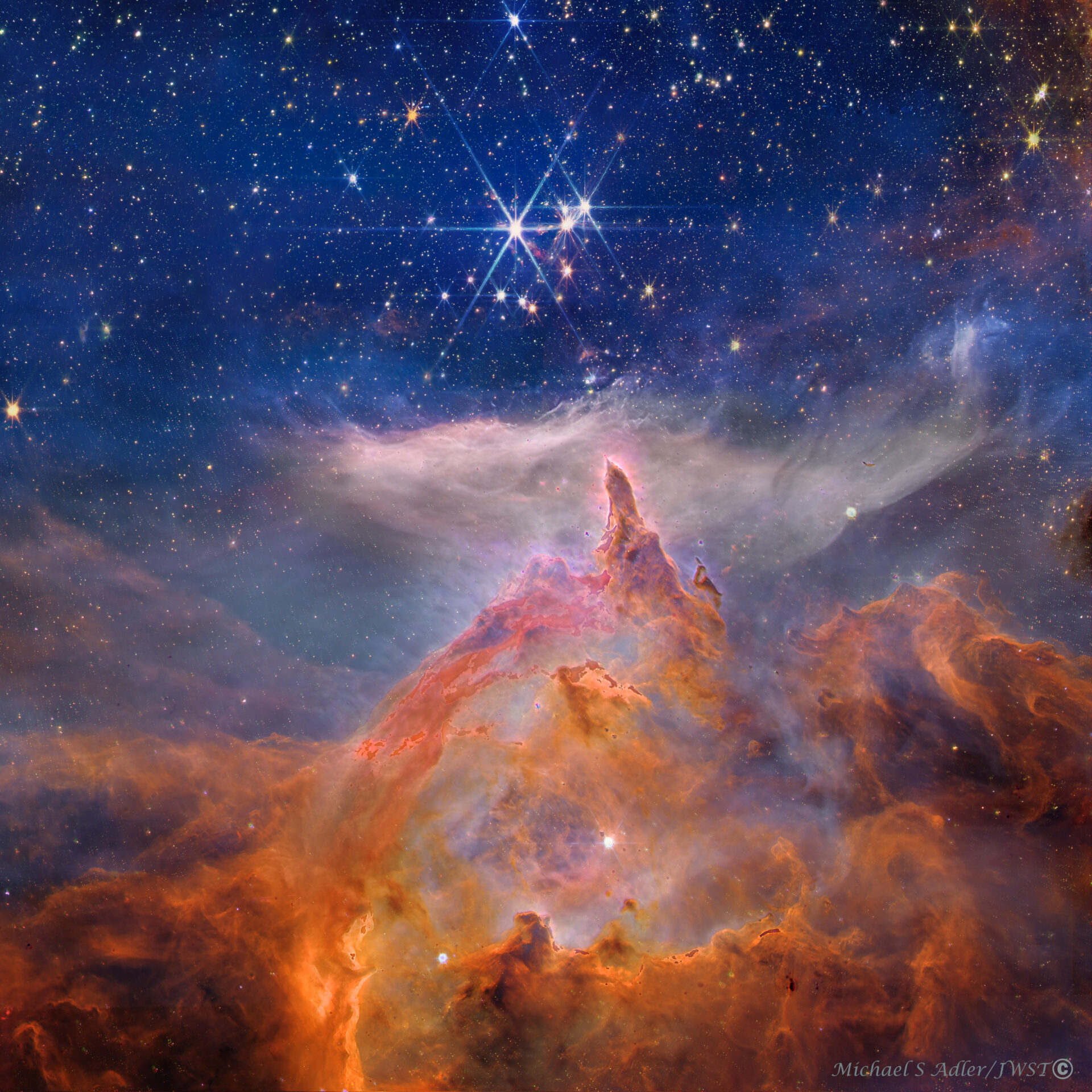Optics: James Webb Space Telescope(JWST)
Mount: JWST
Camera:NIRCAM(JWST Near Infrared Camera)
Filters: 470n,335m,200w,187n,090w
Dates/Times: Sept 2025
Location: Lagrange Point 2 orbit, ~1 million miles from Earth
Exposure Details: Five near infrared filters on the JWST NIRCAM ranging from 900nm to 4700nm
Acquisition: Downloaded from the MAST website(Mikulski Archive For Space Telescopes)
Processing: Maximdl was used to stretch and align the data from the five filters and create an initial three wavelength color image created from the 470n(red),335m(green), and 090w(blue) filters. Photoshop was used to combine this with data from the filters 200w(orange),187n(cyan). Final processing done in PS 2025 and Camera Raw and RCAstro BlurX and StarX.
Pismis 24(JWST)
Original price was: $65.00.$52.50Current price is: $52.50.
Pismis 24, JWST
Called Pismis 24, this young star cluster resides in the core of the nearby Lobster Nebula, approximately 5,500 light-years from Earth in the constellation Scorpius. Home to a vibrant stellar nursery and one of the closest sites of massive star birth, Pismis 24 provides rare insight into large and massive stars. Its proximity makes this region one of the best places to explore the properties of hot young stars and how they evolve.At the heart of this glittering cluster is the brilliant Pismis 24-1. It is at the center of a clump of stars above the jagged orange peaks, and the tallest spire is pointing directly toward it. Pismis 24-1 appears as a gigantic single star, and it was once thought to be the most massive known star. Scientists have since learned that it is composed of at least two stars, though they cannot be resolved in this image. At 74 and 66 solar masses, respectively, the two known stars are still among the most massive and luminous stars ever seen.
Captured in infrared light by Webb’s NIRCam (Near-Infrared Camera), this image reveals thousands of jewel-like stars of varying sizes and colors. The largest and most brilliant ones with the six-point diffraction spikes are the most massive stars in the cluster. Hundreds to thousands of smaller members of the cluster appear as white, yellow, and red, depending on their stellar type and the amount of dust enshrouding them. Webb also shows us tens of thousands of stars behind the cluster that are part of the Milky Way galaxy.
Super-hot, infant stars –some almost 8 times the temperature of the Sun – blast out scorching radiation and punishing winds that are sculpting a cavity into the wall of the star-forming nebula. Dramatic spires jut from the glowing wall of gas, resisting the relentless radiation and winds. They are like fingers pointing toward the hot, young stars that have sculpted them. The fierce forces shaping and compressing these spires cause new stars to form within them. The tallest spire spans about 5.4 light-years from its tip to the bottom of the image. More than 200 of our solar systems out to Neptune’s orbit could fit into the width its tip, which is 0.14 lightyears.
In this image, the color cyan indicates hot or ionized hydrogen gas being heated up by the massive young stars. Dust molecules similar to smoke here on Earth are represented in orange. Red signifies cooler, denser molecular hydrogen. The darker the red, the denser the gas. Black denotes the densest gas, which is not emitting light. The wispy white features are dust and gas that are scattering starlight.
This entire image is in false color because the JWST NIRCAM camera is capturing light in the infrared which is not visible to the human eye. There are five different infrared images combined here with red from a 4700nm filter, orange from a 3350nm filter, green from a 2000nm filter, cyan from a 1870nm filter and blue from a 900nm filter. The raw image data was downloaded from the Mikulski Archive for Space Telescopes(MAST) and processed by Michael Adler. I think the image has more detail in the nebula than the NASA version which is shown here.https://assets.science.nasa.gov/dynamicimage/assets/science/missions/webb/science/2025/webb-STScI-01K2JB3KKEFSMGWY9092BM6C7K-11K.tif?w=8088&h=11164&fit=clip&crop=faces%2Cfocalpoint


